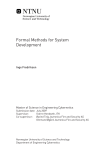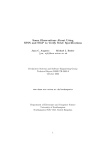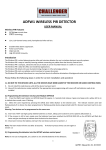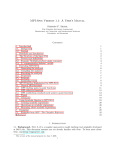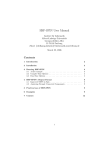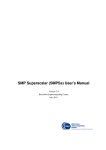Download CS 6110 – Formal Methods – Spring 2011
Transcript
CS 6110 – Formal Methods – Spring 2011
January 14, 2011
Assignment 1, Handed out: January 13 – due dates noted below
These are mainly for class discussions which will be “graded” through questions and interactions with you:
1. Go through the protocols 2_peterson.m and n_peterson.m in the Murphi examples directory. Be ready
to discuss these next week when called upon. Run these protocols and tell me what you observed.
Understand all Murphi constructs in it.
2. Read through the User Manual of Murphi. Be ready to ask me questions. I’ll ask a few too.
3. Be sure you understand the workings of two-bytes.m.
4. I will give you hints on how my coding of bubble sort is going. You can take these hints and see if you
can finish up coding. Look online for illustration2.
5. Please read Chapter 2 of Stern’s dissertation. We can all have a discussion around the items there.
This is a problem you must all work on individually.
In an old algorithms textbook, the following Bubblesort routine was (actually) given. I give it in pseudocode. I also give it in Promela, another language like Murphi. Your task is to code up this model suitably in
Murphi. Then write an invariant to claim that this protocol sorts.
Tell me whether the invariant is true, and if not why not. Hint: I am not claiming that this
Bubble sort is correct. So if the Bubble sort is not correct, your final invariant should help you
debug it.
Also my pseudo-code in illustration2 is just a rough sketch of some work—it is not a complete piece of
code yet. It won’t even compile.
Schedule for your presentation:
• Initial Murphi coding due by next week Monday midnight (1/17). You need not have fully tested it, but I
must see enough Murphi code to know that you have made progress. Submit it as version1_bubsort_yourname.m.
• More working Murphi code to be submitted Wednesday midnight (1/19). Name your submission
version2_bubsort_yourname.m. We will discuss your work then. Document your progress since previous
version.
• Final working code to be submitted by Monday midnight of 1/24. We will set up a handin directory. Call
it final_bubsort_yourname.m.
1
• EXTRA CREDIT: Model the rules of a correct Bubble sort program and verify it using
Murphi. You don’t need to follow the same code pattern as below – you can write your own Bubble sort
pseudo-code and verify that using Murphi.
procedure bubblesort;
var j, t: integer;
begin
repeat
t:=a[1];
for j:=2 to N do
if a[j-1]>a[j] then
begin t:=a[j-1]; a[j-1]:=a[j]; a[j]:=t end
until t=a[1];
end;
/* -- This happens to be a Promela model for the above -- */
#define Size 5
#define aMinIndx 1
#define aMaxIndx (Size-1)
/* Gonna "waste" a[0] because Sedgewick uses 1-based arrays */
active proctype bubsort()
{ byte j, t;
/* Init to 0 by SPIN */
bit a[Size]; /* Use 1-bit abstraction */
/* Nondeterministic array initialization */
do ::break ::a[1]=1 ::a[2]=1 ::a[3]=1 ::a[4]=1 od;
t=a[aMinIndx];
j=aMinIndx+1;
do /* First ‘‘repeat’’ iteration */
:: (j >(aMaxIndx)) -> break /*-- For-loop exits --*/
:: (j<=(aMaxIndx)) ->
if
:: (a[j-1] > a[j]) -> t=a[j-1]; a[j-1]=a[j]; a[j]=t
:: (a[j-1] <= a[j])
fi;
j++
od;
do /* Subsequent ‘‘repeat’’ iterations */
:: t!=a[1] ->
t=a[aMinIndx];
j=aMinIndx+1;
2
do
:: (j >(aMaxIndx)) -> break /*-- For-loop exits --*/
:: (j<=(aMaxIndx)) ->
if
:: (a[j-1] > a[j]) -> t=a[j-1]; a[j-1]=a[j]; a[j]=t
:: (a[j-1] <= a[j])
fi;
j++ /*-- for-index increments --*/
od
/*-- end of for-loop --*/
:: t==a[1] -> break
od;
t=1; /*-- Comb from location-1 to look for sortedness --*/
do
:: t < aMaxIndx-1 -> t++
:: t > aMinIndx
-> t-:: a[t] > a[t+1] -> assert(0) /*- announce there is a bug! -*/
od
}
3



